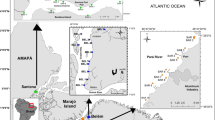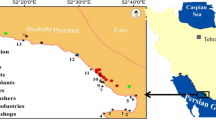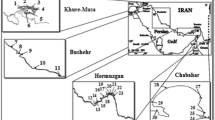Abstract
Aim and Background
Little data are available on the levels of polycyclic aromatic hydrocarbons (PAHs) in the sediments of the Mediterranean Sea Coast of Egypt in general and the Alexandria coastal zone in particular. It was therefore deemed necessary to set up a monitoring programme to determine the current concentrations of PAHs in bottom sediments, and to identify any area where high concentrations of these potential hazardous contaminants were present in the Western Harbour of Alexandria.
Methods
The composition, distribution and the source of PAHs in surficial sediments of the harbour were investigated. To document the spatial PAH input, surficial sediment samples from 23 locations throughout the harbour were analysed. as]Results and Discussion
The total PAH load determined in the surficial sediment samples ranged from 8 to 131150 ng g1 dry wt, generally with most of the samples having total concentrations of PAHs greater than 5000 ng g1 dry weight. The highest concentration of total PAHs was recorded in sediments of the inner harbour. Ratio values of specific compounds such as phenanthrene to anthracene, fluoranthrene to pyrene, methyl-phen-anthrene to phenanthrene, methyl-dibenzothiophenes to dibenzothiophenes, alkylated to non-alkylated and high molecular weight to low molecular weight PAH, were calculated to evaluate the possible source of PAH contamination in the harbour sediments.
Conclusions
Two main sources of PAH in the study area have been found: pyrolytic and petrogenic. Interferences of rather petrogenic and pyrolytic PAH contaminations were noticed for most samples. The dominant sources of PAH appear to be the combustion processes through run-off, industrial and sewage discharges, and atmospheric input. The concentrations of PAHs were generally above levels expected to cause adverse biological effects.
Recommendations and outlook
Information from this study and any other relevant studies should be useful in designing future strategies for environmental protection and management of the harbour.
Similar content being viewed by others
References
Abd-Allah AMA, El Sebae A (1995): Hydrocarbon contamination of the Egyptian Mediterranean coast. Toxicology & Environmental Chemistry 47, 15–22
Baird C (1995): Environmental Chemistry. W.H. Freeman and Company, New York, pp. 276–278
Baumard P, Budzinski H, Garrigues P (1998): Polycyclic aromatic hydrocarbons in sediments and mussels of the Western Mediterranean Sea. Environmental Toxicology and Chemistry 17, 765–776
Benlahcen KT, Chaoui A, Budzinski H, Bellocq J, Garrigues P (1997): Distribution and sources of polycyclic aromatic hydrocarbons in some Mediterranean coastal sediments. Marine pollution Bulletin 34, 298–305
Benner BA, Gordon GE, Wise SA (1989): Mobile sources of atmospheric polycyclic aromatic hydrocarbons: A roadway tunnel study. Environmental Science and Technology 23, 1269–1278
Blumer M (1976): Polycyclic aromatic compounds in nature. Scientific American 234, 34–35
Botello AV, Calva LB (1998): Polycyclic aromatic hydrocarbons in sediments from Pueblo Viejo, Tamiahua, and Tampamachoco Lagoons in the Southern Gulf of Mexico. Bulletin of Environmental Contamination and Toxicology 60, 96–103
Budzinski H, Jones I, Bellocq J, Pierard C, Garrigues P (1997): Evaluation of sediment contamination by polycyclic aromatic hydrocarons in the Gironde esturary. Marine Chemistry 58, 85–97
Chiou CT, McGroddy SE, Kile DE (1998): Partitition characteristics of polycyclic aromatic hydrocarbons on soils and sediments. Environmental Science and Technology 32, 264–269
Coakley J, Nagy E, Serodes J (1993): Spatial and vertical trends in sediment-phase contaminants in the Upper Estuary of the St. Lawrence Rivers, Estuaries 16, 653–669
Colombo JC, Pelltier E, Brochu C, Khalil M (1989): Determination of hydrocarbon sources using n-alkane and polyaromatic hydrocarbon distribution indexes. Case study: Rio de La Plata Estuary, Argentina. Environmental Science and Technology 23, 888–894
Dachs J, Bayona JM, Raoux C, Albaiges J (1997): Spatial, vertical distribution and budget of polycyclic aromatic hydrocarbons in the western Mediterranean seawater. Environmental Science and Technology 31, 682–688
Garrigues P, Budzinski H, Manitz MP, Wise SA (1995): Pyrolytic and petrogenic inputs in recent sediments: a definitive signature through phenanthrene and chrysene compound distribution. Polycyclic Aromatic Compounds 7, 275–284
Gearing PJ, Gearing JN, Pruell RJ, Wade TL, Quinn JG (1980): Partitioning of No. 2 fuel oil in controlled estuarine ecosystem, sediments and suspended particulate matter. Environmental Science and Technology 14, 1129–1135
Gevao B, Jones KC, Hamilton-Taylor J (1998): Polycyclic aromatic hydrocarbons (PAH) deposition to and processing in a small rural lake, Cuumbria UK. Science of the Total Environment 215, 231–242
Gschwend PM, Hites RA (1981): Fluxes of polycyclic aromatic hydrocarbons to marine and lacustrine sediments in the northeastern United States. Geochimica et Cosmochimica Acta 45, 2359–2367
Harvey RG (1996): Polycyclic Aromatic Hydrocarbons. Willey New York, pp 8#x2013;11
Hong H, Xu, L, Zhang L, Chen JC, Wong YS, Wan TSM (1995): Environmental fate and chemistry of organic pollutants in the sediment of Xiamen harbour and Victoria harbour. Marine pollution Bulletin 31, 229–236
Jackson TJ, Wade TL, McDonald TJ, Wilkinson DL, Brooks JM (1994): Polynuclear aromatic hydrocarbon contaminants in oysters from the Gulf of Mexico (1986–1990). Environmental Pollution 83, 291–298
Law RJ, Biscaya JL (1994): Polycyclic aromatic hydrocarbons (PAH)-Problems and progress in sampling, analysis and interpretation. Marine Pollution Bulletin 29, 235–241
Lipiatou E, Saliot A (1991): Hydrocarbon contamination of the Rhone Delta and Western Mediterranean. Marine Pollution Bulletin 22, 291–304
Lipiatou E, Albaiges J (1994): Atmospheric deposition of hydrophobic organic chemicals in the northwestern Mediterranean Sea: Comparison with the Rhone River input. Marine Chemistry 46, 153–164
Lipiatou E, Tolosa I, Simo R, Bouloubassi I, Dachs J, Marti S, Sicre MA, Bayona JM, Grimalt, JO, Saliot A, Albaiges J (1997): Mass Budget and dynamics of polycyclic aromatic hydrocarbons in the Mediterranean Sea. Deep-Sea Research II 44. 881–905
Long ER, MacDonald DD, Smith SL, Calder FD (1995): Incidence of adverse biological effects within ranges of chemical concentrations in marine and estuarine sediments. Environmental Management 19, 81–97
Maher WA, Aislabie J (1992): Polycyclic aromatic hydrocarbons in nearshore marine sediments of Australia. Science of the Total Environment 112, 143–1640
McDonald TJ, Kennicutt II MC (1992): Fractionation of crude oils by HPLC and quantitative determination of aliphatic and aromatic biological markers by GC/MS-SIM. LC-GC 10(12), 935–938
Merrill EG, Wade TL (1985): Carbonized coal products as a source of aromatic hydrocarbons to sediments from a highly industrialized estuary. Environmental Science and Technology 19, 597–603
Mostafa A, Barakat AO, Qian Y, Wade TL (2001): An overview of metal pollution in the Western Harbour of Alexandria, Egypt. Environment 2001, The 3rd International Conference & Trade Fair for Environmental Management and Technologies, 29–31 Oct. 2001, Cairo, Egypt
Muel B, Saguem S (1985): Determination of 23 polycyclic aromatic hydrocarbons in atmospheric particulate matter of the Paris area and photolysis by sun light. Environmental Science and Technology 19, 111–131
Nes K, Oug E (1997): Multivariate approach to distribution patterns and fate of polycyclic aromatic hydrocarbons in sediments from smelter-affected Norwegian fjords and coastal waters. Environmental Science and Technology 31, 1253–1258
Nett JM (1979): Polycyclic Aromatic Hydrocarbons in the Aquatic Environment Sources. Fates and Biological Effects. Applied Science, London, pp. 7–33
Petera WE, Hostettler FD, Luoma SN, van Geen A, Fuller CC, Anima RJ (1999): Sedimentary record of anthropogenic and biogenic polycyclic aromatic hydrocarbons in San Francisco Bay, CA. Marine Chemistry 64, 99–113
Prahl FG, Carpenter R (1983): Polycyclic aromatic hydrocarbons (PAH+ Phase association in Washington coastal sedimentary particulates from Dadob Bay. Washington DC. Geochimica et Cosmochimica Acta 47, 1013–1023
Qian Y, Wade TL, Sericano SL (2002): The distribution and sources of polynuclear aromatic hydrocarbons in Galveston Bay, TX. Estuaries (in review)
Raoux CY, Garrigues P (1991): Mechanical model of polycyclic aromatic hydrocarbons contamination of marine coastal sediments from the Mediterranean Sea. Polycyclic Aromatic Compounds Supplement 3, 443–450
Shiaris MP, Sweet DJ (1986): Polycyclic aromatic hydrocarbons in surficial sediments of Boston Harbour, MA, USA. Marine pollution Bulletin 17, 469–472
Short WJ, Jackson TJ, Larsen ML, Wade TL (1996): Analytical methods used for the analysis of Hydrocarbons in Crude Oil, Tissues, Sediments, and Seawater collected for the Natural Resources Damage Assessment of the Exxon Valdez Oil Spill, American Fisheries Society Symposium 18, 140–148
Shrama M, McBean EA, Marsalek J (1997): Source characterization of polycyclic aromatic hydrocarbons in street and creek sediments. Water Quality Research Journal of Canada 32, 23–35
Sicre MA, Marty JC, Saliot A, Aparicio X, Grimalt J, Albaiges J (1987): Aliphatic and aromatic hydrocarbons in different sized aerosols over the Mediterranean Sea: occurrence and origin. Atmospheric Environment 21, 2247–2259
Simpson CD, Mosi AA, Cullen WR, Reimer KJ (1996): Composition and distribution of polycyclic aromatic hydrocarbons in surficial and distribution of polycyclic aromatic hydrocarbons in surficial marine sediments from Kitimat Harbour, Canada. The Science of the Total Environment 181, 265–278
Soclo HH, Garrigues PH, Ewald M (2000): Origin of polycyclic aromatic hydrocarbons (PAHs) in coastal marine sediments case studies in Cotonou (Benin) and Aquitaine (France) areas. Marine Pollution Bulletin 40, 387–396
Stegeman JJ, Lech JJ (1991): Cytochrome P-450 monooxygenase system in aquatic species: Carcinogen metabolism and biomarkers for carcinogen and pollutant exposure. Environmental Health Perspectives 90, 101–109
Suess MJ (1976): The environmental load and cycle of polycyclic aromatic hydrocarbons. Science of the Total Environment 6, 239–250
Tarn NFY, Ke L, Wang XH, Wong YS (2001): Contamination polycyclic aromatic hydrocarbons I surface sediments of mangrove swamps. Environmental Pollution 114, 225–263
Tolosa I, Bayona JM, Albaiges J (1996): Aliphatic and polycyclic aromatic hydrocarbons and sulfur/oxygen derivatives in northwestern Mediterranean sediments: Spatial and temporal variability, fluxes, and budgets, Environmental Science and Technology 30, 2495–2503
Wakeham SG, Schaffner C, Giger W (1980): Polycyclic aromatic hydrocarbons in recent lake sediments: I. Compounds having anthropogenic origins, Geochimica et Cosmochimica Acta 44, 403–413
Witt G (1995): Polycyclic aromatic hydrocarbons in water and sediment of the Baltic Sea. Marine Pollution Bulletin 31, 237–248
Yang GP (2000): Polycyclic aromatic hydrocarbons in the sediments of the South China Sea. Environmental Pollution 108, 163–171
Youngblood WW, Blumer M (1975): Polycyclic aromatic hydrocarbons in the environment: Homologous series in soils and recent marine sediments. Geochimica et Cosmochimica Acta 39, 1303–1314
Yuan D, Yang D, Wade TL, Qian Y (2001): Status of persistent organic pollutants in the sediment from several estuaries in China. Environmental Pollution 114, 101–111
Author information
Authors and Affiliations
Corresponding author
Rights and permissions
About this article
Cite this article
Mostafa, A.R., Barakat, A.O., Qian, Y. et al. Composition, distribution and sources of polycyclic aromatic hydrocarbons in sediments of the western harbour of alexandria, egypt. J Soils & Sediments 3, 173–179 (2003). https://doi.org/10.1065/jss2003.02.069
Received:
Accepted:
Issue Date:
DOI: https://doi.org/10.1065/jss2003.02.069




